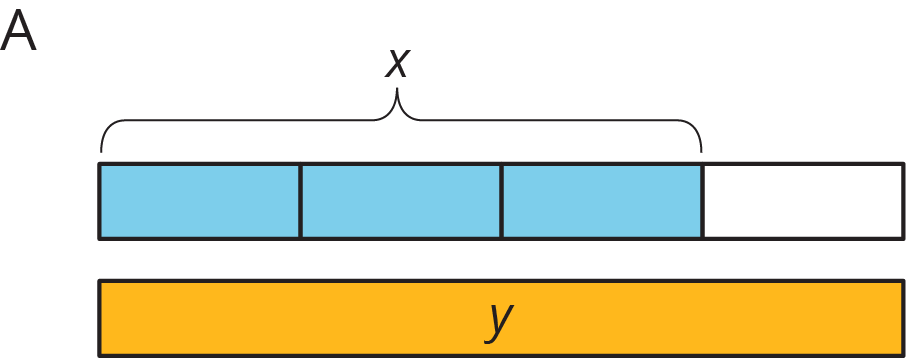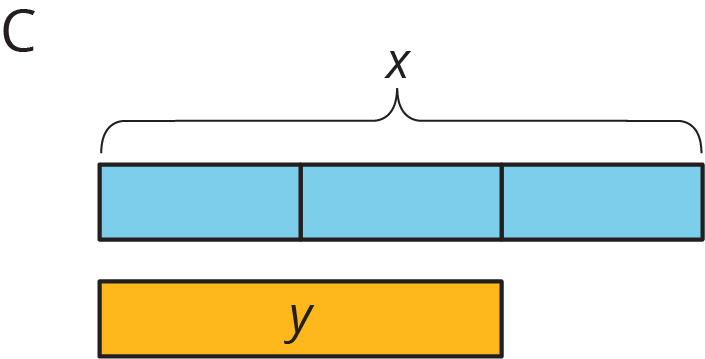Lesson 4
Half as Much Again
4.1: Notice and Wonder: Tape Diagrams (5 minutes)
Warm-up
The purpose of this warm-up is to elicit the idea that there are different ways to represent a value, which will be useful when students apply the distributive property to write expressions in a later activity. While students may notice and wonder many things about these images, the similarities and differences between the two tape diagrams are the important discussion points.
Launch
Arrange students in groups of 2. Tell students that they will look at an image, and their job is to think of at least one thing they notice and at least one thing they wonder. Display the image for all to see. Ask students to give a signal when they have noticed or wondered about something. Give students 1 minute of quiet think time, and then 1 minute to discuss the things they notice with their partner, followed by a whole-class discussion.
Student Facing
What do you notice? What do you wonder?

Student Response
For access, consult one of our IM Certified Partners.
Activity Synthesis
Ask students to share the things they noticed and wondered. Record and display their responses for all to see. If possible, record the relevant reasoning on or near the image. After each response, ask the class if they agree or disagree and to explain alternative ways of thinking, referring back to the images each time. If the total length of the first diagram does not come up during the conversation, ask students to discuss this idea.
4.2: Walking Half as Much Again (10 minutes)
Activity
In this activity, students find patterns in situations to connect to the distributive property (MP7). These patterns build understanding of the equations \(x + 0.5x = (1 + 0.5)x = 1.5x\) or \(x + \frac12x = (1 + \frac12)x = 1\frac12x\). Students should see that the expressions are all representations of the same thing. Students learn that multiplying a number by \(\frac12\) and adding that product to the original numbers is the same as multiplying by 1.5. This idea is extended to percents in the following activity.
As students work on the task, monitor the reasoning they come up with for the question comparing Mai and Kiran's representations (MP3). Identify students who agree with both Mai and Kiran; these students should be chosen to share during the discussion.
Launch
Demonstrate, or ask students to demonstrate, walking a certain distance and then walking “half as much again”. Ask students how they could draw a tape diagram to represent the first situation. For example, they could draw something like this.

Give students 5 minutes of quiet work time followed by partner and then whole-class discussion.
Student Facing
-
Complete the table to show the total distance walked in each case.
- Jada’s pet turtle walked 10 feet, and then half that length again.
- Jada’s baby brother walked 3 feet, and then half that length again.
- Jada’s hamster walked 4.5 feet, and then half that length again.
- Jada’s robot walked 1 foot, and then half that length again.
- A person walked \(x\) feet and then half that length again.
initial distance total distance 10 3 4.5 1 \(x\) - Explain how you computed the total distance in each case.
-
Two students each wrote an equation to represent the relationship between the initial distance walked (\(x\)) and the total distance walked (\(y\)).
- Mai wrote \(y = x + \frac12 x\).
- Kiran wrote \(y = \frac32x\).
Do you agree with either of them? Explain your reasoning.
Student Response
For access, consult one of our IM Certified Partners.
Student Facing
Are you ready for more?
Zeno jumped 8 meters. Then he jumped half as far again (4 meters). Then he jumped half as far again (2 meters). So after 3 jumps, he was \(8 + 4 + 2 = 14\) meters from his starting place.
- Zeno kept jumping half as far again. How far would he be after 4 jumps? 5 jumps? 6 jumps?
- Before he started jumping, Zeno put a mark on the floor that was exactly 16 meters from his starting place. How close can Zeno get to the mark if he keeps jumping half as far again?
- If you enjoyed thinking about this problem, consider researching Zeno's Paradox.
Student Response
For access, consult one of our IM Certified Partners.
Anticipated Misconceptions
Students might struggle coming up with an expression in terms of \(x\). Ask students to describe how you would calculate it in words, then see if they can use that to write the expression.
When comparing Kiran and Mai's equations, even though there is no coefficient written in front of the \(x\) in Mai's equation, \(x\) is equivalent to \(1x\).
Activity Synthesis
Ask selected students to share who they agree with (Mai or Kiran) and have them explain how they know. Highlight instances when students are reasoning with the distributive property, and encourage them to identify it by name. Suggested questions:
- “Are Mai and Kiran's equations equivalent?”
- “What is the same and what is different about the two equations?”
- “How does each equation represent the “one and a half” relationship between the quantities?”
- “How else could you write an equation to represent the relationship?” (\(y=(1+0.5)x\), \(y = \frac32 x\), \(y = 1x + 0.5x\)) Students should see that the equations express the same relationship and understand why.
Supports accessibility for: Language; Social-emotional skills
Design Principle(s): Support sense-making; Maximize meta-awareness
4.3: More and Less (10 minutes)
Activity
The purpose of this activity is to connect various representations of proportional relationships including images, equations, and descriptions. Students first match descriptions of a proportional relationship, involving a variable \(x\), to tape diagrams that represent the situations. Then they create equations that describe the proportion using only variables. Finally, they apply their understanding to create their own scenarios and describe a proportional relationship, which is already represented in the form of a tape diagram.
The focus of the discussion following the activity is on the numbers used to go from between significant quantities in a proportional relationship. For example, what numbers are relevant as we go from the quantity of blueberries eaten by Han to the quantity eaten by Mai?
Launch
Arrange students in groups of 2. Give students 1--2 minutes of quiet think time followed by partner discussion on the first problem. Then give students 3--5 minutes to complete the problems. Follow with whole-class discussion.
Supports accessibility for: Visual-spatial processing
Student Facing
-
Match each situation with a diagram. A diagram may not have a match.




- Han ate \(x\) ounces of blueberries. Mai ate \(\frac13\) less than that.
- Mai biked \(x\) miles. Han biked \(\frac23\) more than that.
- Han bought \(x\) pounds of apples. Mai bought \(\frac23\) of that.
- For each diagram, write an equation that represents the relationship between \(x\) and \(y\).
- Diagram A:
- Diagram B:
- Diagram C:
- Diagram D:
- Write a story for one of the diagrams that doesn't have a match.
Student Response
For access, consult one of our IM Certified Partners.
Anticipated Misconceptions
Students may match the equation \(y = \frac23 x\) with the situation “Mai biked \(x\) miles, and Han biked \(\frac23\) more than that.” Ask them who biked farther, Han or Mai? The equation they choose must result in Han biking a greater distance than Mai.
Activity Synthesis
After students complete the task, ask students to share a few of their arguments for the matches they came up with (not all need to be shared). Questions you could ask them as they share:
- What is different about the numbers in the description and the numbers in the equation?
- How is the number in the equation related to the number in the description?
- What is different between a fractional amount more than the original versus less than the original?
Design Principle(s): Maximize meta-awareness; Support sense-making
4.4: Card Sort: Representations of Proportional Relationships (10 minutes)
Optional activity
In this activity, students receive a set of cards that have 3 different representations of proportional relationships (table, equation, description). The purpose of this activity is for students to interpret wording like “y is \(\frac13\) more than x” and figure out how that relationship can be expressed using different mathematical representations. Students may initially think that the wording means \(y=\frac13 x\), however the numbers in the table representation will help them realize that this is not true. They are engaging in this reasoning here in preparation for upcoming work on percent increase and decrease.
They will work with their partner to match the different representations with each other (each set should contain a table, equation and description) and explain their reasoning (MP3).
There are 8 groups of 3 to match up. Here is an example of one of the groups of 3:

Launch
Demonstrate how to set up and do the matching activity. Choose a student to be your partner. Mix up the rest of the cards and place them face-up. Point out that each card contains a description, table, or equation. Select one of each style of card and then explain to your partner why you think the cards do or do not match. Demonstrate productive ways to agree or disagree (e.g., by explaining your mathematical thinking, asking clarifying questions, etc.).
Arrange students in groups of 2. Give each group pre-printed cut-up slips for matching. Place two copies of uncut blackline masters in envelopes to serve as answer keys.
Supports accessibility for: Conceptual processing; Organization
Student Facing
Your teacher will give you a set of cards that have proportional relationships represented three different ways: as descriptions, equations, and tables. Mix up the cards and place them all face-up.
-
Take turns with a partner to match a description with an equation and a table.
- For each match you find, explain to your partner how you know it’s a match.
- For each match your partner finds, listen carefully to their explanation, and if you disagree, explain your thinking.
- When you agree on all of the matches, check your answers with the answer key. If there are any errors, discuss why and revise your matches.
Student Response
For access, consult one of our IM Certified Partners.
Anticipated Misconceptions
Students may match the equation \(y = \frac23 x\) with the situation “Elena biked \(x\) miles, and Noah biked \(\frac23\) more than that.” Ask them who biked farther, Noah or Elena? The equation they choose must result in Noah biking a greater distance than Elena.
Activity Synthesis
After students complete the task, ask students to share a few of their arguments for the matches they came up with (not all need to be shared). Questions you could ask them as they share:
- What is different about the numbers in the description and the numbers in the equation?
- How is the number in the equation related to the number in the description?
- What is different between a fractional amount more than the original versus less than the original?
Lesson Synthesis
Lesson Synthesis
Students should understand the role the distributive property plays in making calculations more efficient. Ask students:
- “Give examples of how we can use the distributive property to create equivalent expressions that make it easier for us to calculate an amount plus (or minus) a fraction of that amount.” (e.g. \(x + \frac12 x = 1\frac12 x\))
- “What does this look like in different representations?” (refer to the card sort examples)
4.5: Cool-down - Fruit Snacks and Skating (5 minutes)
Cool-Down
For access, consult one of our IM Certified Partners.
Student Lesson Summary
Student Facing
Using the distributive property provides a shortcut for calculating the final amount in situations that involve adding or subtracting a fraction of the original amount.
For example, one day Clare runs 4 miles. The next day, she plans to run that same distance plus half as much again. How far does she plan to run the next day?

Tomorrow she will run 4 miles plus \(\frac12\) of 4 miles. We can use the distributive property to find this in one step: \(1 \boldcdot 4 + \frac{1}{2} \boldcdot 4 = \left(1 + \frac{1}{2}\right) \boldcdot 4\)
Clare plans to run \(1\frac12\boldcdot 4\), or 6 miles.
This works when we decrease by a fraction, too. If Tyler spent \(x\) dollars on a new shirt, and Noah spent \(\frac{1}{3}\) less than Tyler, then Noah spent \(\frac{2}{3}x\) dollars since \(x-\frac{1}{3}x=\frac{2}{3}x\).